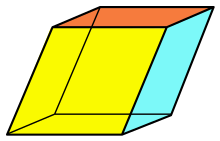Rhombohedron

A rhombohedron is a polyhedron bounded by six diamonds . It is a parallelepiped with equally long edges.
volume
The volume of a rhombohedron with the side length and the angle ( ) is given by
- .
The surface surrenders to
- .
Applied rhombohedra
Art and nature
- In his partly mathematically inspired graphic Melencolia I, Albrecht Dürer depicts a specially trimmed rhombohedron , which through this modification would lie with all of its corner points on a spherical surface.
- Maurits Cornelis Escher also used various rhombohedra for his impossible figures in preliminary considerations and structural development.
Crystallography
The rhombohedron can be found in nature as a crystal form and at the atomic level in crystal structures . It is the general planar shape of the rhombohedral crystal class ( 3 ), a border shape of the trigonal-trapezoidal ( 32 ) and a special shape of the ditrigonal-scalenohedral crystal class ( 3 m ). It is also the basic shape of the rhombohedral Bravais lattice and the (no longer in use) rhombohedral crystal system . The rhombohedron as a crystal form only exists in the trigonal crystal system ; it has nothing to do with the (ortho-) rhombic crystal system - despite the similar name.
Calcite crystal
The color thrombohedron
According to Harald Küppers, the color rhombohedron fulfills the geometric solution for his theory of colors . Each point within the body corresponds to a color valence . This means that each of these (color) points is defined by its three vector potentials. The color rhombohedron can be converted into an RGB or a CYM color space through compression and distortion , naturally with different ratios (vectors) between the color values.
A rhombohedron, in which the short diagonal of the outer surfaces is as long as the rhombohedron sides, represents a symmetrical parallelepiped. There are two outer surfaces parallel to each other. Each diamond-shaped outer surface consists of two equilateral triangles. If you cut a rhombohedron along the short diagonal of the outer surfaces, you get three parts: two tetrahedra and one octahedron. Again, these three bodies are completely symmetrical. All of the outer surfaces of these three new geometric bodies are equilateral triangles.
Web links
- Blue calcite rhombohedron
- Diamond body
- Eric W. Weisstein : Rhombohedron . In: MathWorld (English).
Individual evidence
- ↑ from Augsburg Naturmuseum, found Goslerwand, East Tyrol
- ↑ Museo civico di storia naturale a Milano, location Kazakhstan
- ↑ Location China: rhombeohedral yellow transparent crystal: Calcite jaune
- ^ Illustration from Encyclopædia Britannica (1911), article CALCITE.
- ↑ Küppers' Theory of Colors ( Memento of the original from January 26, 2012 in the Internet Archive ) Info: The archive link was inserted automatically and not yet checked. Please check the original and archive link according to the instructions and then remove this notice.
- ↑ W: white, S: black, N: neutral gray, B → M → R → Y → G → C: six bright colors (blue, magenta, red, yellow, green, cyan)













